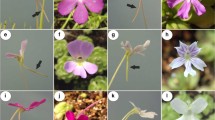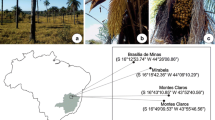Abstract
The South-East Asian palm genus Eugeissona has an unusual flower structure, and it occupies a basal position in the early divergent palm subfamily Calamoideae. This article describes the floral structure of Eugeissona tristis, a palm that has been associated with an uncommon pollination syndrome in which non-flying mammals ingest large amounts of fermenting nectar produced by flowers. Our study focuses on the architecture of the nectaries responsible for this nectar production. The nectariferous tissues differentiate in four histological regions along the length of the gynoecium, and appear to be primarily associated with ventral slits of the carpels, corresponding to pollen tube transmitting tracts (PTTT). Nectariferous tissues also develop along the carpel septa—as is typical for the Monocotyledons—but to a much lesser extent. A comprehensive review of the nectariferous systems diversity in palms confirms that it represents an undescribed type of nectary unique to the family, and demonstrates a topographical shift when compared to the septal or labyrinthine types typical of other palms. The non-flying mammal pollination syndrome observed in Eugeissona tristis is described and compared with similar syndromes in other angiosperms.



Similar content being viewed by others
References
Asmussen CB, Dransfield J, Deikmann V, Barfod AS, Pintaud JC, Baker WJ (2006) A new subfamily classification of the palm family (Arecaceae): evidence from plastid DNA phylogeny. Bot J Linn Soc 151:15–38
Baker WJ, Couvreur TLP (2012) Global biogeography and diversification of palms sheds light on the evolution of tropical lineages. I. Historical biogeography. J Biogeogr 40:274–285
Baker WJ, Savolainen V, Asmussen CB, Chase MW, Dransfield J, Forest F, Harley M, Uhl NW, Wilkinson M (2009) Complete generic-level phylogenetic analyses of palms (Arecaceae) with comparisons of supertree and supermatrix approaches. Syst Biol 58:240–256
Balhara M, Stauffer FW, Balslev H, Barfod A (2013) Floral structure and organogenesis of the wax palm Ceroxylon ceriferum (Arecaceae; Ceroxyloideae). Amer J Bot 100:2132–2140
Barfod A, Dransfield J (2013) Arecaceae (Palmae). In: Santisuk T et al (eds). F1 Thailand 11:323–498
Barfod A, Hagen M, Borchsenius F (2011) Twenty-five years of progress in understanding pollination mechanisms in palms (Arecaceae). Ann Bot (Oxford) 108:1503–1516
Beccari O (1918) Asiatic palms—Lepydocaryeae. Ann Roy Bot Gard (Calcutta) 12:1–231
Bobrov A, Dransfield J, Romanov MS, Romanova ES (2012) Gynoecium and fruit histology and development in Eugeissona (Calamoideae: Arecaceae). Bot J Linn Soc 168:377–394
Bosch E (1947) Blütenmorphologische und zytologische Untersuchungen an Palmen. Ber Schweiz Bot Gess 57:37–100
Carthew SM, Coldingay RL (1997) Non-flying mammals as pollinators. Trends Ecol Evol 12:104–108
Castaño F, Stauffer FW, Marquinez X, Crèvecoeur M, Collin M, Pintaud JP, Tregear J (2014) Floral structure and development in the monoecious palm Gaussia attenuata (Arecaceae; Arecoideae). Ann Bot 114:1483–1495
Cunningham SA (1995) Ecological constraints on fruit initiation by Calyptrogyne ghiesbreghtiana (Arecaceae): floral herbivory, pollen availability, and visitation by pollinating bats. Amer J Bot 82:1527–1536
Dransfield J (1970) Studies on the Malayan palms Eugeissona and Johannesteijsmannia. PhD Thesis, Cambridge University, Cambridge
Dransfield J, Uhl NW (1998) Palmae. In Kubitski K (ed) The families and genera of vascular plants. IV. Flowering plants. Monocotyledons. Springer, Berlin
Dransfield J, Uhl NW, Asmussen CB, Baker WJ, Harley MM, Lewis CE (2008) Genera Palmarum: the evolution and classification of palms. Royal Botanic Gardens, Kew, Richmond
Endress PK (1994) Diversity and evolutionary biology of tropical flowers. Cambridge University Press, Cambridge
Faegri K, van der Pijl L (1979) The principles of pollination ecology. Pergamon Press, Oxford, New York and Toronto
Gottsberger G, Silberbauer-Gottsberger I (2006) Life in the Cerrado: a South American tropical seasonal ecosystem, vol II. Reta, Ulm
Grünmeier R (1992) Untersuchungen zur Chiropterophilie zweier Leguminosen Kameruns, Parkia bicolor und Mucuna flagellipes, sowie zum Verhalten und Nahrungsspektrum der bestäubenden Flughunde (Megachiroptera, Pteropodidae). PhD Thesis, Universität Mainz, Mainz
Guevara L (2010) Morfoanatomía reproductiva y relaciones filogenéticas de la subtribu Mauritiinae Meisn. (Arecaceae: Calamoideae). PhD Thesis, Universidad Central de Venezuela, Maracay, p 221
Guevara L, Rudall PJ, Stauffer FW, Jáuregui D (2010) Estructura y desarrollo de las escamas en el ovario de Mauritia flexuosa L. F. (Arecaceae, Calamoideae, Mauritiinae). Ernstia 20:159–167
Guevara L, Jáuregui D, Stauffer FW (2014) Estructura floral de dos especies de Trachycarpeae (Arecaceae). Revista Biol Trop 62:1137–1146
Heithaus ER (1982) Coevolution between bats and plants. In: Kuntz TH (ed) Ecology of bats. Plenum Press, New York, London, pp 327–367
Henderson A (2009) Palms of Southern Asia. Princeton University Press, Princeton; New York Botanical Garden, Bronx
Igersheim A, Cichoki O (1996) A simple method for microtome sectioning of prehistoric charcoal specimens, embedded in 2-hydroxyethyl methacrylate (HEMA). Rev Palaeobot Palynol 92:389–393
Kress WJ, Beach JH (1994) Flowering plant reproductive systems. In: McDade LA, Bawa KS, Hespenheide H, Hartshorn GS (eds) La Selva, ecology and natural history of a neotropical rainforest. University of Chicago Press, Chicago, pp 161–182
Küchmeister H, Silberbauer-Gottsberger I, Gottsberger G (1997) Flowering, pollination, nectar standing crop, and nectaries of Euterpe precatoria (Arecaceae), an Amazonian rain forest palm. Pl Syst Evol 206:71–97
Leins P, Erbar C (2008) Blüte und Frucht: Morphologie, Entwicklungsgeschichte, Phylogenie, Funktion, Ökologie. E. Schweizbart’sche Verlagsbuchhandlung, Stuttgart
Nadot S, Sannier J, Barfod A, Baker WJ (2011) Evolution of the palm androecium as revealed by character mapping on a supertree. In: Warnntorp L, Ronse De Craene LP (eds) Flowers on the tree of life. Cambridge University Press, Cambridge, pp 156–180
Orbach DN, Veselka N, Dzal Y, Lazure L, Fenton MB (2010) Drinking and flying: does alcohol consumption affect the flight and echolocation performance of phyllostomid bats? PLOS One 5:e8993
Rudall PJ, Abranson K, Dransfield J, Baker WJ (2003) Floral anatomy in Dypsis (Arecaceae–Areceae): a case of complex synorganisation and stamen reduction. Bot J Linn Soc 143:115–133
Rudall PJ, Ryder RA, Baker WJ (2011) Comparative gynoecium structure and multiple origins of apocarpy in Coryophoid palms (Arecaceae). Int J Pl Sci 172:674–690
Schmid R (1983) Septal nectaries of Asterogyne martiana and other Palmae. Principes 27:168–174
Silberbauer-Gottsberger I (1973) Blüten- und Fruchtbiologie von Butia leiospatha (Arecaceae). Österr Bot Zeitschrift 121:171–185
Silberbauer-Gottsberger I (1990) Pollination and evolution in palms. Phyton (Horn) 30:213–233
Sperr EB, Fronhofer EA, Tschapka M (2009) The Mexican mouse opossum (Marmosa mexicana) as a flower visitor at a Neotropical palm. Mammalian Biol 74:76–80
Stauffer FW, Endress PK (2003) Comparative morphology of staminate flowers and systematics in Geonomeae (Arecaceae). Pl Syst Evol 242:171–203
Stauffer FW, Rutishauser R, Endress PK (2002) Morphology and development of the staminate flowers in Geonoma interrupta (Arecaceae). Amer J Bot 89:220–229
Stauffer FW, Baker WJ, Dransfield J, Endress PK (2004) Comparative floral structure and systematics of Pelagodoxa and Sommieria (Arecaceae). Bot J Linn Soc 146:27–39
Stauffer FW, Barfod A, Endress PK (2009) Development and structure in the flowers of Licuala peltata (Arecaceae: Coryphoideae). Bot J Linn Soc 161:66–77
Sussman RW, Raven PH (1978) Pollination by lemurs and marsupials: an archaic co-evolutionary system. Science 200:731–734
Tschakapa M (2003) Pollination of the understorey palm Calyptrogyne ghiesbreghtiana by hovering and perching bats. Biol J Linn Soc 80:281–288
Uhl NW, Dransfield J (1984) Development of the inflorescence, androecium, and gynoecium with reference to palms. In: White RA, Dickison WC (eds) Contemporary problems in plant anatomy. Academic Press, Orlando, pp 397–449
Uhl NW, Moore HE (1971) The palm gynoecium. Amer J Bot. 58:945–992
van Heel WA (1988) On the development of some gynoecia with septal nectaries. Blumea 33:477–504
Villimova V, Stauffer FW (2013) Floral structure in the Neotropical tribes Leopoldinieae and Manicarieae (Arecaceae: Arecoideae). Palms 57:181–193
Westerkamp C (1999) Blüten und ihre Bestäuber. In: Zizka G, Schneckenburger S (eds) Blütenökologie—faszinierendes Miteinander von Pflanzen und Tieren. Palmengarten Sonderh. 31, Kramer, Frankfurt a. M, pp 25–47
Wiens F, Zitzmann A, Lachance MA, Yegles M, Pragst F, Wurst FM, Holst DV, Guan SW, Spanagel R (2008) Chronic intake of fermented floral nectar by wild treeshrews. Proc Natl Acad Sci USA 105:10426–10431
Wong YK (1959) Autecology of the bertam palm Eugeissona tristis Griff. Mal For 22:301–313
Yumoto T (2005) Vertebrate–pollinated plants. In: Roubik DW, Sakai S, Hamid Karim AA (eds), Pollination ecology and the rain forest: Sarawak studies. Springer, New York, pp 174:134–144
Acknowledgments
We are greatly indebted to Peter Endress (University of Zurich) for critical discussions on floral structure and nectariferous systems in angiosperms. André Piuz (Natural History Museum, Geneva) for support in SEM work. Kevin Nixon (Cornell University, Bailey Hortorium, United States) for kindly providing plant material. William Baker (K) for scientific advice and also for providing photos and critical literature. John Dransfield (Kew) for critical discussions and analysis of scientific data. Frank Wiens (formerly University of Bayreuth, Germany) kindly provided plant material and essential information on the reproductive biology of Eugeissona, and Eliana Schacher, University of Ulm, for preparing the first permanent slides of the material. Ulrich Maschwitz (Goethe-University, Frankfurt am Main) kindly enabled the visiting of I. Silberbauer-Gottsberger in Ulu Gombak, Malaysia. Jennifer DeMuria is greatly thanked for interesting discussions on plant-animals relationships and also for correcting the English.
Author information
Authors and Affiliations
Corresponding author
Ethics declarations
Conflict of interest
The authors declare that they have no conflict of interest.
Additional information
Handling editor: Louis P. Ronse De Craene.
Rights and permissions
About this article
Cite this article
Stauffer, F.W., Siegert, S., Silberbauer-Gottsberger, I. et al. Floral structure in the Asian palm Eugeissona tristis Griff. (Arecaceae: Calamoideae), and description of a new nectary type in the family. Plant Syst Evol 302, 629–639 (2016). https://doi.org/10.1007/s00606-016-1292-8
Received:
Accepted:
Published:
Issue Date:
DOI: https://doi.org/10.1007/s00606-016-1292-8




